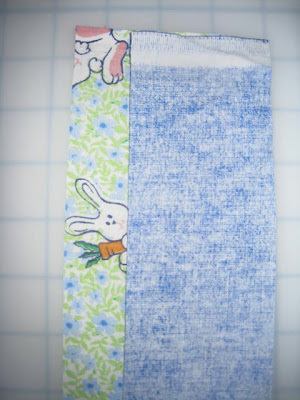If you saw the bunny rabbits among the fabrics for the
mathematical baby quilt, you may have recalled that the 13th century Italian mathematician Leonardo da Pisa, a.k.a. Fibonacci (son of Bonacci), described the hypothetical birth pattern of rabbits resulting in the series of numbers 1, 1, 2, 3, 5, 8 and so on. This has come to be known as the Fibonacci sequence. The pattern I'm adapting from
Mathematical Quilts by Diana Venters and
Elaine Krajenke Ellison is based on the Fibonacci sequence.
For the original pattern, you'll have to check out the book. I've modified the original pattern by extending the Fibonacci sequence from 1, 1, 2, 3, 5 to 1, 1, 2, 3, 5, 8. The original quilt without borders finishes 22 inches square. By adding another number in the sequence, the center without borders finishes 38 inches square. This makes the quilt a reasonable size for a baby quilt. Additionally, if your fabric didn't shrink too much from the standard 44 inches wide, you will be able to cut the pieces for the center with very little wasted fabric. Venters and Ellison suggest purchasing one yard of each fabric for the center. However, even extending the sequence of the quilt, with my cutting plan you can make this center with 22.5 inches (5/8 yard) of each fabric (that's leaving an extra inch for clean up cuts).
The second, and I think more significant, modification is in the construction method. Venters and Ellison suggest something approximating a template approach, cutting out each individual piece and sewing them back together again. I developed a strip piecing construction method that makes short work of constructing this quilt. In my example, the dark fabric is blue and the light fabric is green with rabbits.
Layer the dark and light fabric together so you can cut strips from both fabrics with one cut.

Make a clean up cut to make an even edge. Cut a 1 1/2 inch strip from both the dark and light fabrics from selvage to selvage.

Cut a 2 1/2 inch wide strip from both the dark and light fabrics from selvage to selvage.

Cut a 3 1/2 inch wide strip from both the dark and light fabrics from selvage to selvage.

Cut a 5 1/2 inch wide strip from both the dark and light fabrics from selvage to selvage.

Cut a 8 1/2 inch wide strip from both the dark and light fabrics from selvage to selvage.


Sew the dark 8 1/2 inch strip to the light 5 1/2 inch strip.

Sew the light 8 1/2 inch strip to the dark 5 1/2 inch strip.

Sew the dark 3 1/2 inch strip to the light 2 1/2 inch strip.

Sew the light 3 1/2 inch strip to the dark 2 1/2 inch strip.

Sew the dark 1 1/2 inch strip to the light 1 1/2 inch strip.

Press all seam allowances toward the dark fabric.
Stack strip sets of the same size so you can cut two units with each cut. The seam allowances are pressed in opposite directions, so they should nest perfectly. From each strip set cut 2 8 1/2 inch units, 2 5 1/2 inch units, 2 3 1/2 inch units, 2 2 1/2 inch units, and 2 1 1/2 inch units.
Arrange alternating colors appropriately.
Assemble units into 4-patch blocks.
Assemble 4-patch blocks into 16-patch blocks.
Then complete the center.
You may notice that between cutting the units from the strip sets and assembling the quilt, I did a little machine embroidery on the blue pieces. I embroidered numbers and dots that will be connected by quilting stitches to render various mathematical ideas related to the Fibonacci sequence. For example, Pascal's triangle, polygonal numbers, branching patterns, pathways, and the Golden Rectangle.
Click here to see the rest of this post...












